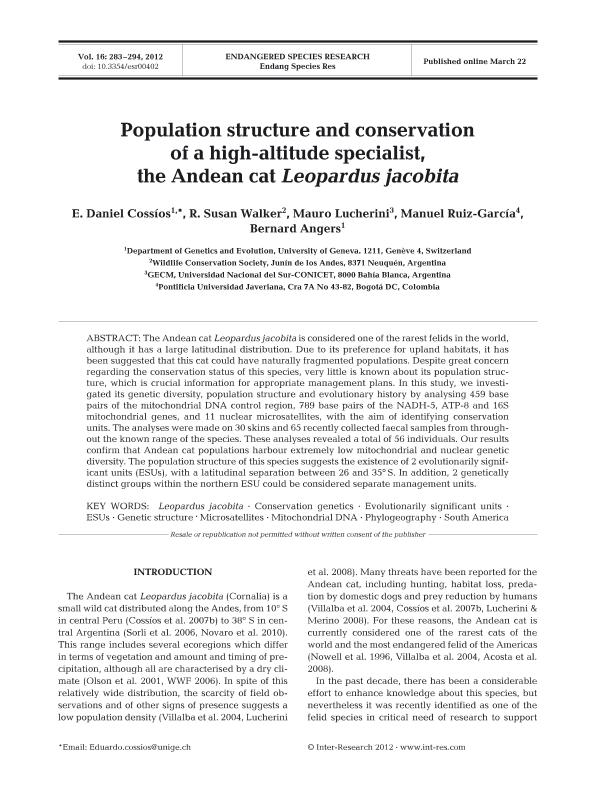Artículo
Population structure and conservation of a high-altitude specialist, the Andean cat Leopardus jacobita
Fecha de publicación:
22/03/2012
Editorial:
Inter-Research
Revista:
Endangered Species Research
ISSN:
1863-5407
e-ISSN:
1613-4796
Idioma:
Inglés
Tipo de recurso:
Artículo publicado
Clasificación temática:
Resumen
The Andean cat Leopardus jacobita is considered one of the rarest felids in the world, although it has a large latitudinal distribution. Due to its preference for upland habitats, it has been suggested that this cat could have naturally fragmented populations. Despite great concern regarding the conservation status of this species, very little is known about its population structure, which is crucial information for appropriate management plans. In this study, we investigated its genetic diversity, population structure and evolutionary history by analysing 459 base pairs of the mitochondrial DNA control region, 789 base pairs of the NADH-5, ATP-8 and 16S mitochondrial genes, and 11 nuclear microsatellites, with the aim of identifying conservation units. The analyses were made on 30 skins and 65 recently collected faecal samples from throughout the known range of the species. These analyses revealed a total of 56 individuals. Our results confirm that Andean cat populations harbour extremely low mitochondrial and nuclear genetic diversity. The population structure of this species suggests the existence of 2 evolutionarily significant units (ESUs), with a latitudinal separation between 26 and 35°S. In addition, 2 genetically distinct groups within the northern ESU could be considered separate management units.
Palabras clave:
LEOPARDUS JACOBITA
,
CONSERVATION GENETICS
,
ESUs
,
GENETIC STRUCTURE
Archivos asociados
Licencia
Identificadores
Colecciones
Articulos(CCT - BAHIA BLANCA)
Articulos de CTRO.CIENTIFICO TECNOL.CONICET - BAHIA BLANCA
Articulos de CTRO.CIENTIFICO TECNOL.CONICET - BAHIA BLANCA
Citación
Cossíos, E. Daniel; Walker, Rebecca Susana; Lucherini, Mauro; Ruiz García, Manuel; Angers, Bernard; Population structure and conservation of a high-altitude specialist, the Andean cat Leopardus jacobita; Inter-Research; Endangered Species Research; 16; 3; 22-3-2012; 283-294
Compartir
Altmétricas




